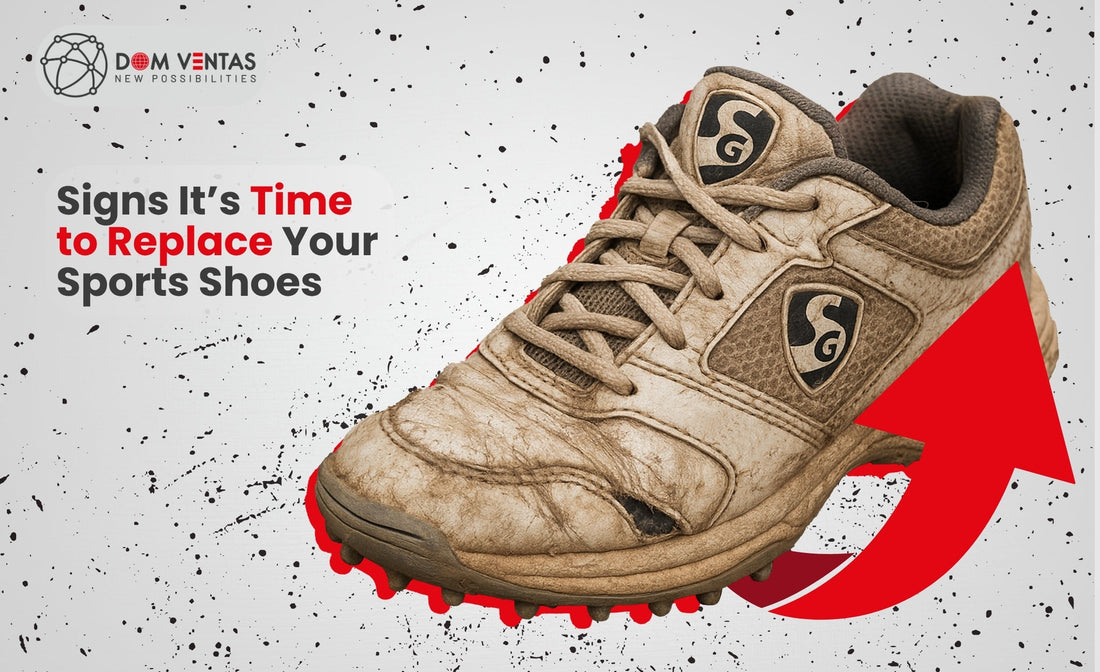
Signs It’s Time to Replace Your Sports Shoes
Your sports shoes are more than just part of your workout outfit—they're your support, your protection, and your performance partner. Whether you’re running, playing football, smashing shuttlecocks, or training in the gym, the right pair of shoes keeps your feet safe and helps you give your best.
But here's the truth: sports shoes don’t last forever.
Even if they look okay, they might not be doing their job anymore. In fact, wearing worn-out shoes can cause pain, injuries, and poor performance. Not cool, right?
So how do you know it’s time to say goodbye to your old pair?
Let’s find out!
👟 1. Your Shoes Have Clocked Too Many Kilometers
Shoes have a mileage limit—just like cars! Most running or sports shoes last around 300 to 500 miles (480 to 800 km). If you’ve been using them regularly for 6–12 months, they’re probably past their best.

Example:
If you run 5 km a day, five days a week, that’s 100 km a month.
In just 6 months, you’ve crossed 600 km—your shoes are likely worn out!
Fact: According to the American Academy of Podiatric Sports Medicine, most athletic shoes should be replaced after about 300–500 miles of use.
Source.
2. The Soles Are Worn Out
Flip your shoes over and take a good look at the outsole (bottom part). Are the treads or grip lines smooth or faded? If yes, it’s time for a new pair!
Why it matters:
The grip helps you stay balanced on turf, track, or court.
A slippery sole increases the risk of slipping and injuries.
Tip: If one side is more worn than the other, it could also be a sign of poor form or posture while running or walking.
🦶 3. Your Feet or Knees Hurt After Playing
This is one of the clearest signs your shoes are saying: “I’ve done my job. Please retire me.”
Pain in your:
- Heels
- Arches
- Knees
- Lower back
...could mean your shoes no longer absorb shock the way they should.
What’s happening:
The midsole, which cushions impact, wears out slowly. You won’t see it from the outside, but your feet will feel it.
Suggestion:
You train hard. Don’t let old shoes undo your effort by causing injury. Your feet deserve better!
✨ 4. Your Shoes Look Bent, Broken, or Tired
Visual signs are important too! Here’s what to check:

- The shoe leans to one side when placed on a flat surface
- The heel is squished or uneven
- There are holes or tears in the upper part
- The inside lining is worn out
Pro Tip:
Take a picture of your shoes when they’re brand new. Compare them 6 months later—you’ll spot the differences easily!
5. They Don’t Feel Right Anymore:
Trust your feet. If your shoes suddenly feel:

- Less comfortable
- Tight in some spots
- Flat or hard
- Uneven while walking or running
...then they’re probably not supporting your feet properly anymore.
Reminder: You don’t need to wait for pain or damage to replace shoes. If they feel “off,” listen to your body—it’s smarter than you think.
Real Talk: Why Replacing Shoes Is a Win
Think of it this way: you wouldn’t keep using a toothbrush with bent bristles, right? Sports shoes are the same—they lose their power over time.
Benefits of Upgrading Your Shoes
-
✅ You reduce injury risk
-
✅ You boost your comfort and confidence
-
✅ You perform better in your workouts or matches
- ✅ You stay motivated to train consistently
And let’s be honest—new shoes feel awesome! They can give your fitness journey a fresh start.
🔄 How to Make Your Shoes Last Longer
You can’t stop shoes from aging, but you can slow it down.
-
👟 Rotate between 2 pairs if you train regularly
-
☔ Keep them dry (no soaking in sweat or rain)
-
🧼 Clean them gently by hand
-
🚫 Never put them in the dryer or near direct heat
- 🧺 Store them in a cool, dry place
Bonus Tip:
Use sport-specific shoes. Don’t wear your football shoes for running or your cricket shoes to the mall.
🧠 Final Thoughts: Stay One Step Ahead
Wearing the right shoes is part of living a healthy lifestyle. It’s not just about fashion—it’s about safety, strength, and feeling good on your feet. So if your shoes are telling you it's time to move on, listen.You deserve gear that supports your fitness goals—not holds you back.


